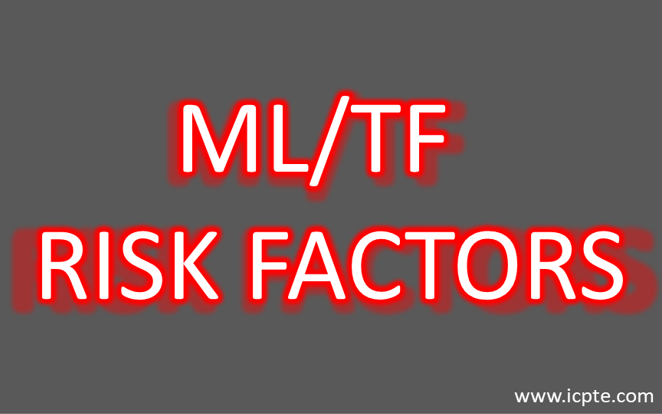The Institute of Continuous Professional Training and Education (ICPTE) offers an extensive variety of Pre-Recorded and Live Online Courses created by Professional and qualified Instructors with years of experience in their field.
ICPTE platform allows You the flexibility to watch online pre-recorded seminars at Your own convenience, at Your own pace, in Your own time and place. Start watching a seminar today and complete it at Your own time. You can have access from anywhere. We work with professional and qualified instructors with years of experience in their field.
The Licensed Firm should assess and measure the level of risk based on the following risk factor indicators:
-
- Client risk
- Service/transaction risk
- Country/Geographical risk
- Delivery Channel Risk
- Client risk
A. Client risk
Each Licensed Firm must determine whether a specific client poses higher risk of ML/TF. Each client is different and will have its own risk profile.
When identifying the risk associated with their customers, including their customers’ beneficial owners, firms should consider the risk related to:
-
- the client’s and the client’s beneficial owner’s business or professional activity, i.e. whether the activity carries a high risk of corruption (e.g. arms dealing), whether it relates to high levels of cash, whether they are regulated etc;
- the client’s and the client’s beneficial owner’s reputation i.e. is there adverse media surrounding the client and the beneficial owners, are they subject to previous suspicion report or have they been convicted etc?
- the client’s and the client’s beneficial owner’s nature and behavior i.e. are they unnecessarily secretive, is their doubt of the veracity of the KYC documents, is there frequent and inexplicable change in ownership etc?
- the client’s and the client’s beneficial owner’s business or professional activity, i.e. whether the activity carries a high risk of corruption (e.g. arms dealing), whether it relates to high levels of cash, whether they are regulated etc;
Risk factors that may be relevant when identifying the risk associated with a customer’s or a customer’s beneficial owner’s business or professional activity include:
a) Does the customer or beneficial owner have links to sectors that are commonly associated with higher corruption risk, such as construction, pharmaceuticals and healthcare, the arms trade and defence, the extractive industries or public procurement?
b) Does the customer or beneficial owner have links to sectors that are associated with higher ML/TF risk, for example certain Money Service Businesses, casinos or dealers in precious metals?
c) Does the customer or beneficial owner have links to sectors that involve significant amounts of cash?
d) Where the customer is a legal person, trust, or other type of legal arrangement, what is the purpose of their establishment? For example, what is the nature of their business?
e) Does the customer have political connections, for example, are they a Politically Exposed Person (PEP), or is their beneficial owner a PEP? Does the customer or beneficial owner have any other relevant links to a PEP, for example are any of the customer’s directors PEPs and, if so, do these PEPs exercise significant control over the customer or beneficial owner? Where a customer or their beneficial owner is a PEP, firms must always apply EDD measures in line with Article 20 of Directive (EU) 2015/849.
f) Does the customer or beneficial owner hold another prominent position or enjoy a high public profile that might enable them to abuse this position for private gain? For example, are they senior local or regional public officials with the ability to influence the awarding of public contracts, decision-making members of high-profile sporting bodies or individuals who are known to influence the government and other senior decision-makers?
g) Is the customer a legal person subject to enforceable disclosure requirements that ensure that reliable information about the customer’s beneficial owner is publicly available, for example public companies listed on stock exchanges that make such disclosure a condition for listing?
h) Is the customer a credit or financial institution acting on its own account from a jurisdiction with an effective AML/CFT regime and is it supervised for compliance with local AML/CFT obligations? Is there evidence that the customer has been subject to supervisory sanctions or enforcement for failure to comply with AML/CFT obligations or wider conduct requirements in recent years?
i) Is the customer a public administration or enterprise from a jurisdiction with low levels of corruption?
j) Is the customer’s or the beneficial owner’s background consistent with what the firm knows about their former, current or planned business activity, their business’s turnover, the source of funds and the customer’s or beneficial owner’s source of wealth?
The following risk factors may be relevant when identifying the risk associated with a customer’s or beneficial owners’ reputation:
a) Are there adverse media reports or other relevant sources of information about the customer, for example are there any allegations of criminality or terrorism against the customer or the beneficial owner? If so, are these reliable and credible? Firms should determine the credibility of allegations on the basis of the quality and independence of the source of the data and the persistence of reporting of these allegations, among other considerations. Firms should note that the absence of criminal convictions alone may not be sufficient to dismiss allegations of wrongdoing.
b) Has the customer, beneficial owner or anyone publicly known to be closely associated with them had their assets frozen due to administrative or criminal proceedings or allegations of terrorism or terrorist financing? Does the firm have reasonable grounds to suspect that the customer or beneficial owner or anyone publicly known to be closely associated with them has, at some point in the past, been subject to such an asset freeze?
c) Does the firm know if the customer or beneficial owner has been the subject of a suspicious transactions report in the past?
d) Does the firm have any in-house information about the customer’s or the beneficial owner’s integrity, obtained, for example, in the course of a long-standing business relationship?
The following risk factors may be relevant when identifying the risk associated with a customer’s or beneficial owner’s nature and behavior. Firms should note that not all of these risk factors will be apparent at the outset; they may emerge only once a business relationship has been established:
a) Does the customer have legitimate reasons for being unable to provide robust evidence of its identity, perhaps because they are an asylum seeker?
b) Does the firm have any doubts about the veracity (authenticity) or accuracy of the customer’s or beneficial owner’s identity?
c) Are there indications that the customer might seek to avoid the establishment of a business relationship? For example, does the customer look to carry out one transaction or several one-off transactions where the establishment of a business relationship might make more economic sense?
d) Is the customer’s ownership and control structure transparent and does it make sense? If the customer’s ownership and control structure is complex or opaque, is there an obvious commercial or lawful rationale?
e) Does the customer issue bearer shares or does it have nominee shareholders?
f) Is the customer a legal person or arrangement that could be used as an asset-holding vehicle?
g) Is there a sound reason for changes in the customer’s ownership and control structure?
h) Does the customer request transactions that are complex, unusually or unexpectedly large, have an unusual or unexpected pattern, no apparent economic or lawful purpose, or lack a sound commercial rationale? Are there grounds to suspect that the customer is trying to evade specific thresholds such as those set out in Article 11(b) of Directive (EU) 2015/849 and national law where applicable?
i) Does the customer request unnecessary or unreasonable levels of secrecy? For example, is the customer reluctant to share CDD information, or do they appear to want to disguise the true nature of their business?
j) Can the customer’s or beneficial owner’s source of wealth or source of funds be easily explained, for example through their occupation, inheritance or investments? Is the explanation plausible (believable)?
k) Does the customer use the products and services they have taken out as expected when the business relationship was first established?
l) Where the customer is a non-resident, could their needs be better serviced elsewhere? Is there a sound economic and lawful rationale for the customer requesting the type of financial service sought?
When identifying the risk associated with a customer’s or beneficial owner’s nature and behaviour, firms should pay particular attention to risk factors that, although not specific to terrorist financing, could point to increased TF risk, in particular in situations where other TF risk factors are also present. To this end, firms should consider at least the following risk factors:
a) Is the customer or the beneficial owner a person included in the lists of persons, groups and entities involved in terrorist acts and subject to restrictive measures or are they known to have close personal or professional links to persons registered on such lists (for example, because they are in a relationship or otherwise live with such a person)?
b) Is the customer or the beneficial owner a person who is publicly known to be under investigation for terrorist activity or has been convicted for terrorist activity, or are they known to have close personal or professional links to such a person (for example, because they are in a relationship or otherwise live with such a person)?
c) Does the customer carry out transactions that are characterised by incoming and outgoing fund transfers from and/or to countries where groups committing terrorist offences are known to be operating, that are known to be sources of terrorist financing or that are subject to international sanctions? If so, can these transfers be explained easily through, for example, family ties or commercial relationships?
d) Is the customer a non-profit organization:
i. whose activities or leadership been publicly known to be associated with extremism or terrorist sympathies? Or
ii. whose transaction behaviour is characterized by bulk transfers of large amounts of funds to jurisdictions associated with higher ML/TF risks and high-risk third countries?
e) Does the customer carry out transactions characterized by large flows of money in a short period of time, involving non-profit organizations with unclear links (e.g. they are domiciled at the same physical location; they share the same representatives or employees or they hold multiple accounts under the same names)?
We mentioned before that we should consider the client’s and the client’s beneficial owner’s business or professional activity, i.e. whether the activity carries a high risk of corruption (e.g. arms dealing), whether it relates to high levels of cash, whether they are regulated etc.
Click HERE to find online seminars on Anti Money Laundering topics


